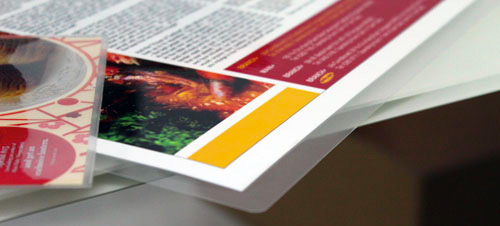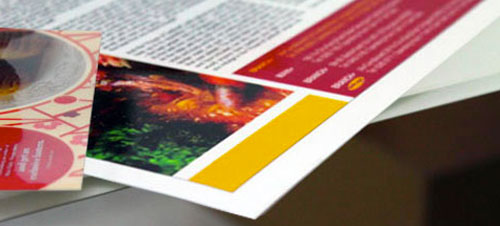Single sided printing will have a blank back, Double sided will be printed on both sides of the sheet of paper.
For mixed backing, provide individual page backing details in the additional instructions box.

Color | 
Black & White |
If your job is mixed Color and Black & White, select Color option and specify the pages that are black and white in the special instructions box.
Please tell us the finished size you want in inches. If you require custom trimming, choose the next largest size and specify details in the Notes.
Printing services has a wide selection of paper choices.
Click here for more information about choosing paper.
Bleeds are when art extends to the edge of the sheet.
Without bleeds, there will be about ¼" white margin around the edges.

Bleeds | 
No Bleeds |
How do I set Bleeds?
A proof is a preliminary version of a printed piece. It provides a close representation of how the piece will appear when printed. Proofs are created to ensure that the client and printer are in complete agreement on the desired outcome before going to press.
Proofs can be viewed in person at Printing Services, mailed or emailed as a PDF.
If you choose not to proof your order, Printing Services will not be held liable for mistakes in the final product.
Drilling / Punching is a process where three holes are drilled along the edge for a 3-ring binder. 2-hole drilling and single-hole (calendar) drilling is also available.
Hole size options include standard 1/4â€, Large 3/8†and calendar 3/16â€. Standard 1/4†holes will be used except when size is specified in additional Instructions.
Lamination is the process of bonding a plastic film onto printed matter. Lamination improves durability and protects against stains, smudges, moisture, wrinkles, and tears. It is a popular choice for printed items that must endure heavy use and/or outdoor elements. This can apply to both small and large format-printing.
- Encapsulated/Sealed Edge- using a layer of lamination film on both sides of a printed piece, where the film is extended beyond the edge of the printed piece by 1/8†to 1/2†so that the top and bottom sheets of laminate bond to each other around the perimeter of the printed piece.
This ensures fluids and dirt never contact the edge of the printed paper substrate.
- Flush Trimmed lamination is used for printed pieces that will not be subject to moisture or excessive dirt or whenever the desired aesthetics warrant a flush edge. Example: interior pages of a book / binder, menus.
 Encapsulated Encapsulated
|
 Flush Trimmed Flush Trimmed
|